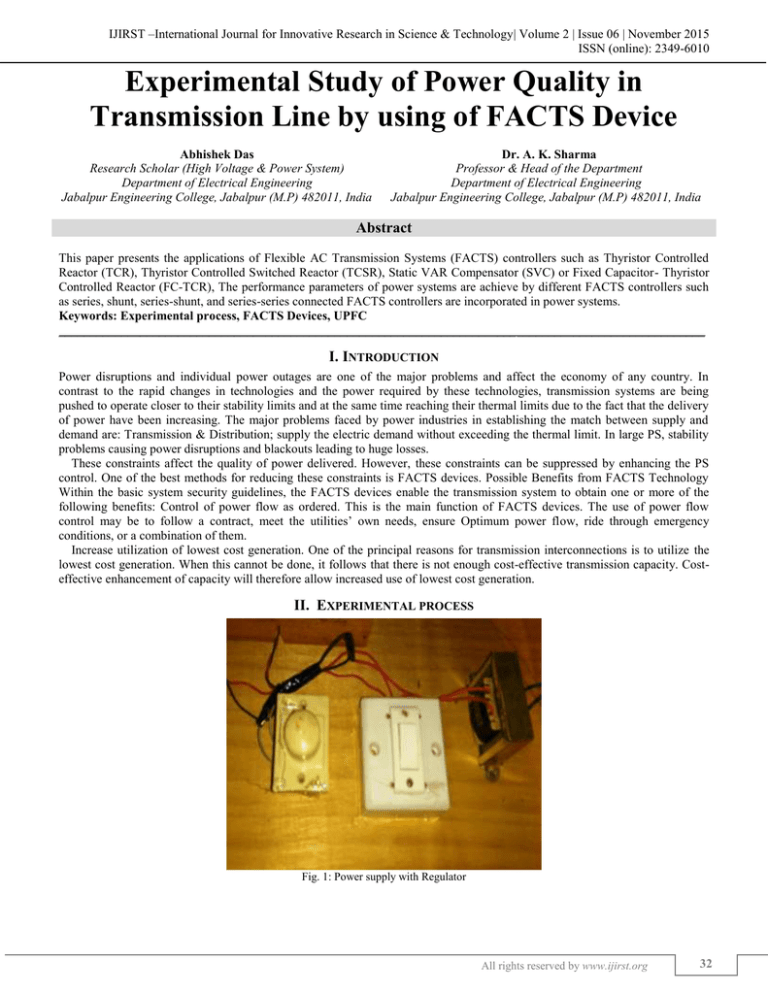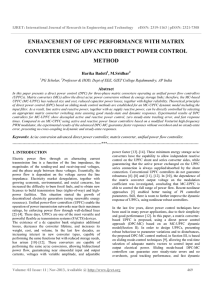
IJIRST –International Journal for Innovative Research in Science & Technology| Volume 2 | Issue 06 | November 2015
ISSN (online): 2349-6010
Experimental Study of Power Quality in
Transmission Line by using of FACTS Device
Abhishek Das
Research Scholar (High Voltage & Power System)
Department of Electrical Engineering
Jabalpur Engineering College, Jabalpur (M.P) 482011, India
Dr. A. K. Sharma
Professor & Head of the Department
Department of Electrical Engineering
Jabalpur Engineering College, Jabalpur (M.P) 482011, India
Abstract
This paper presents the applications of Flexible AC Transmission Systems (FACTS) controllers such as Thyristor Controlled
Reactor (TCR), Thyristor Controlled Switched Reactor (TCSR), Static VAR Compensator (SVC) or Fixed Capacitor- Thyristor
Controlled Reactor (FC-TCR), The performance parameters of power systems are achieve by different FACTS controllers such
as series, shunt, series-shunt, and series-series connected FACTS controllers are incorporated in power systems.
Keywords: Experimental process, FACTS Devices, UPFC
_______________________________________________________________________________________________________
I. INTRODUCTION
Power disruptions and individual power outages are one of the major problems and affect the economy of any country. In
contrast to the rapid changes in technologies and the power required by these technologies, transmission systems are being
pushed to operate closer to their stability limits and at the same time reaching their thermal limits due to the fact that the delivery
of power have been increasing. The major problems faced by power industries in establishing the match between supply and
demand are: Transmission & Distribution; supply the electric demand without exceeding the thermal limit. In large PS, stability
problems causing power disruptions and blackouts leading to huge losses.
These constraints affect the quality of power delivered. However, these constraints can be suppressed by enhancing the PS
control. One of the best methods for reducing these constraints is FACTS devices. Possible Benefits from FACTS Technology
Within the basic system security guidelines, the FACTS devices enable the transmission system to obtain one or more of the
following benefits: Control of power flow as ordered. This is the main function of FACTS devices. The use of power flow
control may be to follow a contract, meet the utilities’ own needs, ensure Optimum power flow, ride through emergency
conditions, or a combination of them.
Increase utilization of lowest cost generation. One of the principal reasons for transmission interconnections is to utilize the
lowest cost generation. When this cannot be done, it follows that there is not enough cost-effective transmission capacity. Costeffective enhancement of capacity will therefore allow increased use of lowest cost generation.
II. EXPERIMENTAL PROCESS
Fig. 1: Power supply with Regulator
All rights reserved by www.ijirst.org
32
Experimental Study of Power Quality in Transmission Line by using of FACTS Device
(IJIRST/ Volume 2 / Issue 06/ 007)
Fig. 2: Transformer with assembly
Fig. 3: Experimental Setup
III. READING AND DISPLAY WITHOUT FILTER AND WITHOUT LOAD
Fig. 4: value of I, P display by analyzer
All rights reserved by www.ijirst.org
33
Experimental Study of Power Quality in Transmission Line by using of FACTS Device
(IJIRST/ Volume 2 / Issue 06/ 007)
Fig. 5: cycle display by analyzer
Fig. 6: value of U display by analyzer
Fig. 7: value of U, f display by analyzer
Fig. 8: value of U, I, P display by analyzer
All rights reserved by www.ijirst.org
34
Experimental Study of Power Quality in Transmission Line by using of FACTS Device
(IJIRST/ Volume 2 / Issue 06/ 007)
IV. READING AND DISPLAY WITH FILTER AND WITH LOAD
Fig. 9: cycle display by analyzer
Fig. 10: value of U display by analyzer
Fig. 11: value of U, f display by analyzer
All rights reserved by www.ijirst.org
35
Experimental Study of Power Quality in Transmission Line by using of FACTS Device
(IJIRST/ Volume 2 / Issue 06/ 007)
Fig. 12: value of U, I, P display by analyzer using of 4700µf capacitor
V. COMPARISON
Table – 1
Reading of Experimental setup
Sr. No. Reading without Filter in Hz Reading with Filter in Hz
1
49.95 Hz
49.96 Hz
Table – 2
Comparison of reading
Sr. No. Parameter Reading without Filter Reading with Filter
1
V1
230.86 V
227.25 V
VI. CONCLUSION
The application of FACTS controllers such series, shunt, series‐shunt, and series‐ series connected FACTS controllers are in
power system environments for enhancement of performance parameters of systems .we are find out the Reading without Filter
are 230.86 V and Reading with Filter are 227.25 V .
REFERENCE
[1]
[2]
[3]
[4]
[5]
[6]
[7]
[8]
P. Kundur, Power System Stability and Control, McGraw-Hill, Inc.,1993
Z.J. Meng, P.L.So, A Current Injection UPFC Model for Enhancing Power System Dynamic Performance
Power System Toolbox, Version 2.0, Cherry Tree Scientific Software, Ontario, Canada
N.G. Hingorani and L. Gyugyi, Understanding FACTS. New York: IEEE Press, 2000.
E. Gholipour and S.Saadate, “ A new method for improving transient stability of power systems by using UPFC,” in Proc. European Power Electronics,
Toulouse, France, Sep. 2003.
Z. Huang et al.,”Application of UPFC in interconnected power systems- Modeling, interface, control strategy, and case study, “ IEEE Trans. Power Syst.,
vol. 15, no. 2, pp. 817-824, May 2000.
K. Schoder, A, hasanovic, and A. feliachi, “ Enhancing transient stability using fuzzy control scheme for the unified power flow controller (UPFC) within
the power system toolbox (PST),” in proc. Midwest Symp. Circuits Systems, vol. 3, lansing, MI, Aug, 2000, pp. 1382-1385.
K.K. Sen and A.J.F. Keri, “Comparison of field results and digital simulation results of voltage-sourced converter-based FACTS controller,” IEEE Trans.
Power Del., vol. 18, no. 1, pp. 300-306, Jan. 2003.
All rights reserved by www.ijirst.org
36







